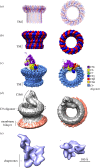The mystery behind membrane insertion: a review of the complement membrane attack complex
- PMID: 28630159
- PMCID: PMC5483522
- DOI: 10.1098/rstb.2016.0221
The mystery behind membrane insertion: a review of the complement membrane attack complex
Abstract
The membrane attack complex (MAC) is an important innate immune effector of the complement terminal pathway that forms cytotoxic pores on the surface of microbes. Despite many years of research, MAC structure and mechanism of action have remained elusive, relying heavily on modelling and inference from biochemical experiments. Recent advances in structural biology, specifically cryo-electron microscopy, have provided new insights into the molecular mechanism of MAC assembly. Its unique 'split-washer' shape, coupled with an irregular giant β-barrel architecture, enable an atypical mechanism of hole punching and represent a novel system for which to study pore formation. This review will introduce the complement terminal pathway that leads to formation of the MAC. Moreover, it will discuss how structures of the pore and component proteins underpin a mechanism for MAC function, modulation and inhibition.This article is part of the themed issue 'Membrane pores: from structure and assembly, to medicine and technology'.
Keywords: MACPF; cholesterol-dependent cytolysin; complement pathway; membrane attack complex; pore-forming protein; pore-forming toxins.
© 2017 The Authors.
Conflict of interest statement
We declare we have no competing interests.
Figures



Similar articles
-
How Structures of Complement Complexes Guide Therapeutic Design.Subcell Biochem. 2021;96:273-295. doi: 10.1007/978-3-030-58971-4_7. Subcell Biochem. 2021. PMID: 33252733 Review.
-
Structural basis of complement membrane attack complex formation.Nat Commun. 2016 Feb 4;7:10587. doi: 10.1038/ncomms10587. Nat Commun. 2016. PMID: 26841837 Free PMC article.
-
Structural basis for the pore-forming activity of a complement-like toxin.Sci Adv. 2025 Mar 28;11(13):eadt2127. doi: 10.1126/sciadv.adt2127. Epub 2025 Mar 28. Sci Adv. 2025. PMID: 40153490 Free PMC article.
-
Conformational changes during pore formation by the perforin-related protein pleurotolysin.PLoS Biol. 2015 Feb 5;13(2):e1002049. doi: 10.1371/journal.pbio.1002049. eCollection 2015 Feb. PLoS Biol. 2015. PMID: 25654333 Free PMC article.
-
Cholesterol-dependent cytolysins.Adv Exp Med Biol. 2010;677:56-66. doi: 10.1007/978-1-4419-6327-7_5. Adv Exp Med Biol. 2010. PMID: 20687480 Review.
Cited by
-
Incorporation of CD55 into the Zika Viral Envelope Contributes to Its Stability against Human Complement.Viruses. 2021 Mar 19;13(3):510. doi: 10.3390/v13030510. Viruses. 2021. PMID: 33808725 Free PMC article.
-
Structure-Guided Engineering of a Complement Component C3-Binding Nanobody Improves Specificity and Adds Cofactor Activity.Front Immunol. 2022 Jul 22;13:872536. doi: 10.3389/fimmu.2022.872536. eCollection 2022. Front Immunol. 2022. PMID: 35935935 Free PMC article.
-
Soluble MAC is primarily released from MAC-resistant bacteria that potently convert complement component C5.Elife. 2022 Aug 10;11:e77503. doi: 10.7554/eLife.77503. Elife. 2022. PMID: 35947526 Free PMC article.
-
Reduced Expression of Membrane Complement Regulatory Protein CD59 on Leukocytes following Lung Transplantation.Front Immunol. 2018 Jan 22;8:2008. doi: 10.3389/fimmu.2017.02008. eCollection 2017. Front Immunol. 2018. PMID: 29403484 Free PMC article.
-
A novel allele of the Arabidopsis thaliana MACPF protein CAD1 results in deregulated immune signaling.Genetics. 2021 Apr 15;217(4):iyab022. doi: 10.1093/genetics/iyab022. Genetics. 2021. PMID: 33779749 Free PMC article.
References
-
- Harriman GR, Esser AF, Podack ER, Wunderlich AC, Braude AI, Lint TF, Curd JG. 1981. The role of C9 in complement-mediated killing of Neisseria. J. Immunol. 127, 2386–2390. - PubMed
Publication types
MeSH terms
Substances
Grants and funding
LinkOut - more resources
Full Text Sources
Other Literature Sources

